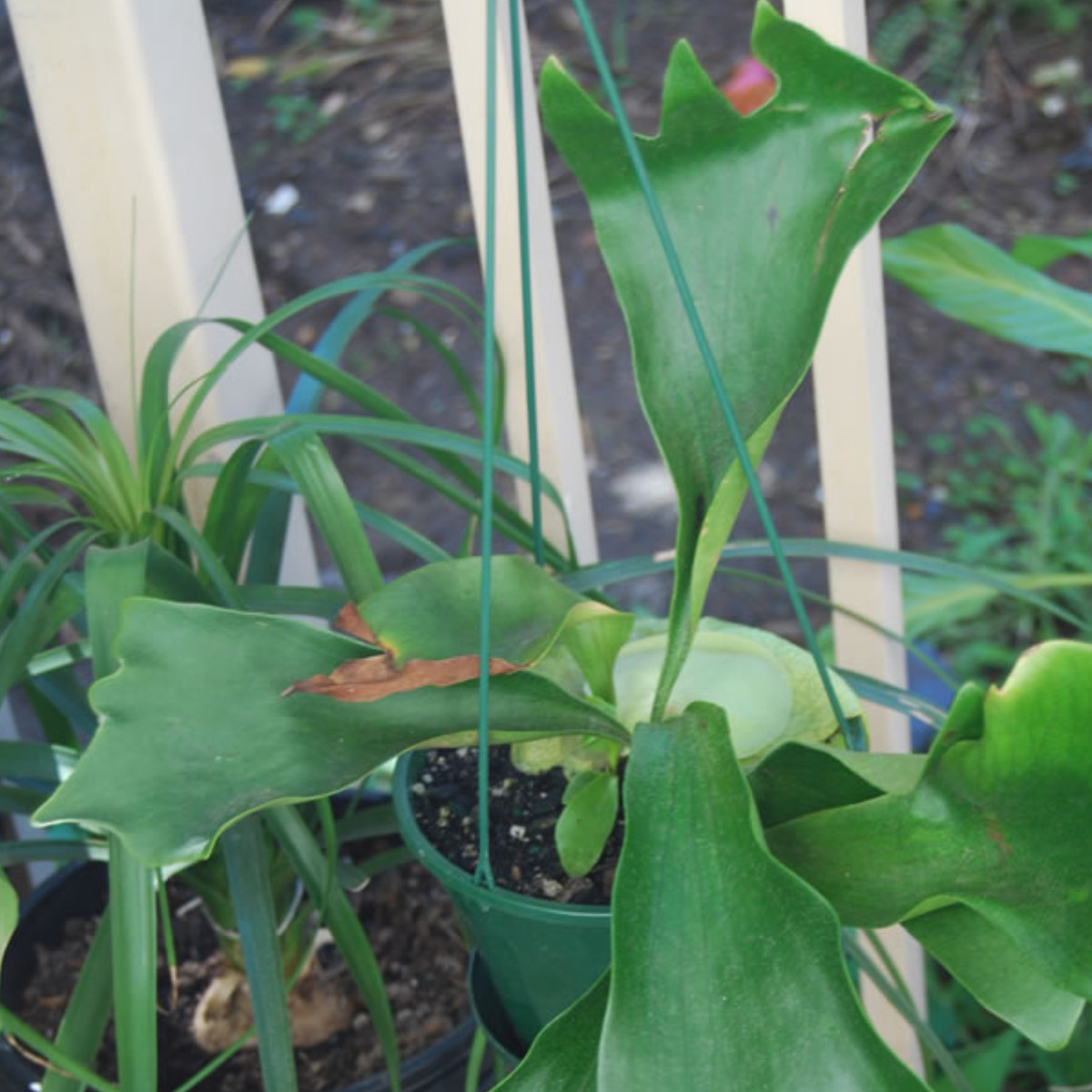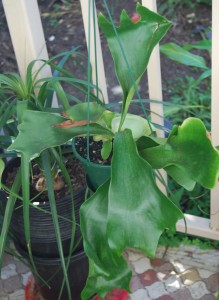Common Names: Elk Horn Fern, Elkhorn, Stag's Horn Fern
Synonymous: Platycerium alcicorne
Family: Polypodiaceae
Distribution and habitat: Platycerium bifurcatum is an epiphytic rainforest fern native to Australia and New Guinea. This fern will fix itself on trunks or branches of trees with a shielded-shaped frond that clasps on its host bark. A second type of fronds grows on the same fern - the fertile fronds - spreading or drooping and forked like a stag's antlers, which is what gives its common name.
Decsription: Platycerium bifurcatum is growing to 90cm (35 inch) tall by 80cm (31 inch) broad, it has two kinds of fronds: heart-shaped sterile fronds and arching grey-green fertile fronds. The sterile fronds are 1245cm (518 inch) long growing at the base of the plant and clasps the plant's support. The fertile fronds are forked and strap-shaped and grow up to 90cm (35 inch) long.
The sterile frond main function is - apart form holding the plant to its support - to trap debris that can be broken down into nutrients as it falls from the branches of the host tree. In time this frond becomes brown and papery and a new green one forms in its place.
The single sterile frond is constantly being replaced, each new one appearing as a small silver spot on top of its predecessor and gradually spreading over the dry brown rather papery surface of the earlier one. When it is young, the new 'shield' is a soft peppermint green, which gradually turns brown. At first it clings tightly to the brown patch bellow it, but is unfurls for the last few centimeters (1 inch) of its growth and it is this upward-turning section that catches falling leaves and any other tree debris in the wild.
The fertile fronds are more decorative. They are several in number, fleshy and deep green which is overlaid with fine, white, felty scurf. The overlay of white scurf give the fronds a silvery green appearance. When mature, they have brown spores arranged in dense clusters on their undersides, mainly concentrated at the tips of the fronds.
The fertile fronds develop from the centre of the sterile one; they can extend up to about a metre (3 feet) or so with each of the terminal 'antlers' as much as 22cm (9 inch) long. These long folds are often semi-erect with the divided parts drooping a little. There are a number of quite different forms, which have fronds of varying colours and length.
Houseplant care: Platycerium bifurcatum is much the easiest species of Platycerium to grow indoors. It will do best when it grows on a pieces of rough bark or tree fern. Alternatively, Platycerium bifurcatum can grow in moss filled baskets.
Clean the fronds by leaving them in gentle rain in mild weather or by mist-spraying them; Wiping them with a soft cloth or sponge is not a good idea as it will remove the attractive felty scurf. Do not allow water to remain on the fronds.
Light: Platycerium bifurcatum should be kept in a well-lit position away from direct sun.
Strong direct sunlight, however, will rob the fronds of much of their colour and may cause unsightly markings.
Temperature: Platycerium bifurcatum likes temperatures up to 24C (75F) as long as humidity is maintained high. An ideal summer temperature is about 21C (70F) with a minimum winter temperature of 10C (50F).
Maintain a humid atmosphere by mist-spraying the plant once a day.
Airy, well ventilated places suits these ferns best. For this reason is best to grow them suspended on a piece of bark or in hanging baskets.
Water: During the spring and summer give to Platycerium bifurcatum enough water at every watering to make the potting mixture thoroughly moist, but allow the potting mixture to dry out almost completely before watering again. During the rest period water these ferns much more sparingly than in the growing period, giving only enough water to make the mixture barely moist throughout.
Because the 'shield' frond often covers the surface, it may be virtually impossible to water some potted Platycerium bifurcatum from above. The way to solve this problem is to submerge the root portion in a large container of water until it is soaked. During the active growth period leave the plant in water for 15 minutes or so at each watering. During the rest period leave the plant in the water for no more then one or two minutes at a time. Whatever the plant is growing actively or resting, do not soak it again until it is obviously in need of water, which will be indicated by abnormally droopy fronds or by an evident loos of weight of the plant.
Fertilising: Feeding is rarely necessary, but mature plants - especially those growing on bark - should have two or three applications of standard liquid fertiliser during the period of active growth. For a satisfactory feeding, the bark section that carries the roots should be immersed for a few minutes in the fertiliser solution until it is thoroughly soaked.
Potting and repotting: There are three ways to grow Platycerium bifurcatum. The most natural way is to let them attach themselves to the rough and moist surface of a piece of bark or similar material; another way is to plant them in wooden hanging baskets; the least satisfactory way is to pot them.
Platycerium bifurcatum plants are often sold growing on a piece of tree fern or bark. When the sterile fronds of such plants have almost covered their backing, fasten the fern onto larger piece of material, either tying or carefully nailing the two together.
To fasten a plant initially to bark wrap the small, spongy root mass in an equal parts mixture of very coarse peat moss and sphagnum moss and tie this bundle securely to the backing with some strong cotton - not nylon - thread. Keep both bark and root mass moist until the roots (which are sparse) and the sterile fronds have adhered to the support.
Alternatively, plant the fern in a wooden, slatted hanging basket (similar to those used for orchids) which is filled with same mixture of peat and sphagnum moss. When established, the plant will gasp the slats firmly.
Platycerium bifurcatum can be grown in pots only when very small, since they wrap their supportive fronds around the pot, which must be broken to sever their hold. It is extremely difficult to move them into larger containers.
Gardening: Within its hardiness zones the Platycerium bifurcatum it is usually grown outdoors.When you grow them epiphytically on a tree, the way they do in nature, they require very little care. The sterile fronds collect falling debris which composts itself in the space between the frond and the tree. This composted organic material absorbs water during rains, which the plant uses when rain becomes scarce.
If not in suitable climate for leaving these plants outdoors all year long,Platycerium bifurcatum is attached to a piece of wood or is grown in hanging baskets. In both cases the fern can be sheltered to safety during harsh winter conditions.
Place them in a well lit position away from direct sun and care them as per indicated above.
Propagation: Propagation is usually from spores and not practical for the indoor amateur grower.
Larger plants occasionally develop more than one growing point and a small side growth can be detached without harming the rest of the plant; this can be treated as a new young specimen on bark or in a basket.
More often, however, old plants are broken up into several separate sections, but it should be kept in mind that the braking-up process may cause considerable damage to some sections.
Problems: Any problems that arise are likely to be the result of incorrect care - insufficient humidity in hot dry conditions or overwatering in winter.
Dry indoor air will cause brown tips.
Treatment: Mist the fronds regularly to keep the humidity high.
However, do not allow the base of the fern to stay wet, which may cause it to rot.
Avoid damaging the fronds by over-handling.
Platycerium bifurcatum are not often troubled with pests, but scale insects sometimes infest the underside of the fronds.
Treatment: They can be treated by applying methylated spirit on a fine-tipped brush direct to each on the insects.
Uses: Platycerium bifurcatum is used as house plant. It is best grown on large slab of bark or wood. It can also be effective in a hanging basket.
Outdoors Platycerium bifurcatum can be grown epiphytically on a tree as well as mounted on a piece of wood or grown in hanging baskets in shaded position.
SUMMARY:
CHARACTERISTICS:
Foliage green
Shape climbing
Height: 60-90 cm (24-36 inch)
PROPER CARE:
Watering in rest period sparingly
Watering in active growth period plentifully
Light bright
Temperature in rest period min 13C max 18C (55-64F)
Temperature in active growth period min 18C max 24C (64-75F)
Humidity high
Hardiness zone: 10a 11
Begonia propagation f...
Essential Nutrients f...
Portulacaria afra
Tillandsia recurvata
Tillandsia stricta
Columnea microphylla
Clivia miniata
Cleyera japonica
Clerodendrum thomsoni...
Cleistocactus strausi...



